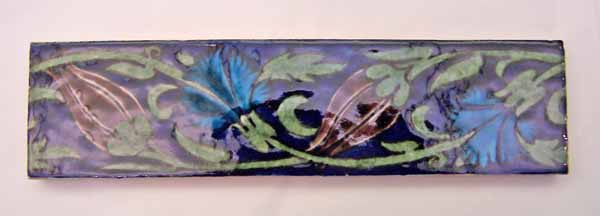wall tile
William Frend de Morgan 1839 - 1917
Summary
Panel of plastic-bodied earthenware tiles with hand-transferred underglaze 'Persian' leaf and flower decoration, two of them large square tiles and fourteen of them smaller border tiles, consisting of two large central tiles, four small square border tiles and eight narrow rectangular border tiles. All the tiles are coated with white slip and decorated with hand-transferred underglaze 'Persian' colours: dark blue, turquoise, green, purple and black. The small corner squares each have a white flower. The other tiles all have a dark blue background. The border tiles have a design of scrolling green foliage, turquoise carnations and purple 'tulips'. The central tiles, not in themselves a complete panel, have a design of white carnations and 'Persian'-style green and white serrated 'saz' leaves. The border tiles, which are of identical design to those of the ship panels 1918.292 and 1918.299, are in fact two too many for the two main tiles and may actually belong to the group of four 'Argyll' tiles (1918.294/4), as suggested by the slides (see below).
Display Label
Gallery text panel The Pre-Raphaelites in their Time Britain's first and best-known radical art movement emerged from within the Royal Academy in 1848. Its original members were rebellious art students who were disillusioned with contemporary practice. They looked back to Italian art before Raphael, seeing the pre-1500 period as one of great sincerity. They called themselves the Pre-Raphaelite Brotherhood. In an age of rapid industrial and urban expansion, Pre-Raphaelite artists like Rossetti, Hunt and Millais, and pioneering design reformers such as William Morris, sought a return to pre-industrial values of art and design in truth to nature and materials, and good workmanship. In addition, the arts of the Middle Ages and Middle East were important sources of stylistic inspiration. The Bible, literature and contemporary life were preferred over subjects derived from classical mythology. The Brotherhood also rejected contrived studio lighting and took canvases outside to paint directly from nature. Although attempting to convey exactly what they saw, they created a heightened reality of dream-like intensity with minute details and bright, dazzling colours. Their art was a new kind of history painting for a new age.
Object Name
wall tile
Creators Name
Date Created
1882=1888
Dimensions
: 1.2cm
Length - Central tiles and rectangular border: 20.3cm
Length -Square border tiles: 5.1cm
accession number
1941.18/2
Collection Group
Place of creation
Merton Abbey
Medium
On Display
[G7] Manchester Art Gallery - Gallery 7
View all
Legal
© Manchester Art Gallery




